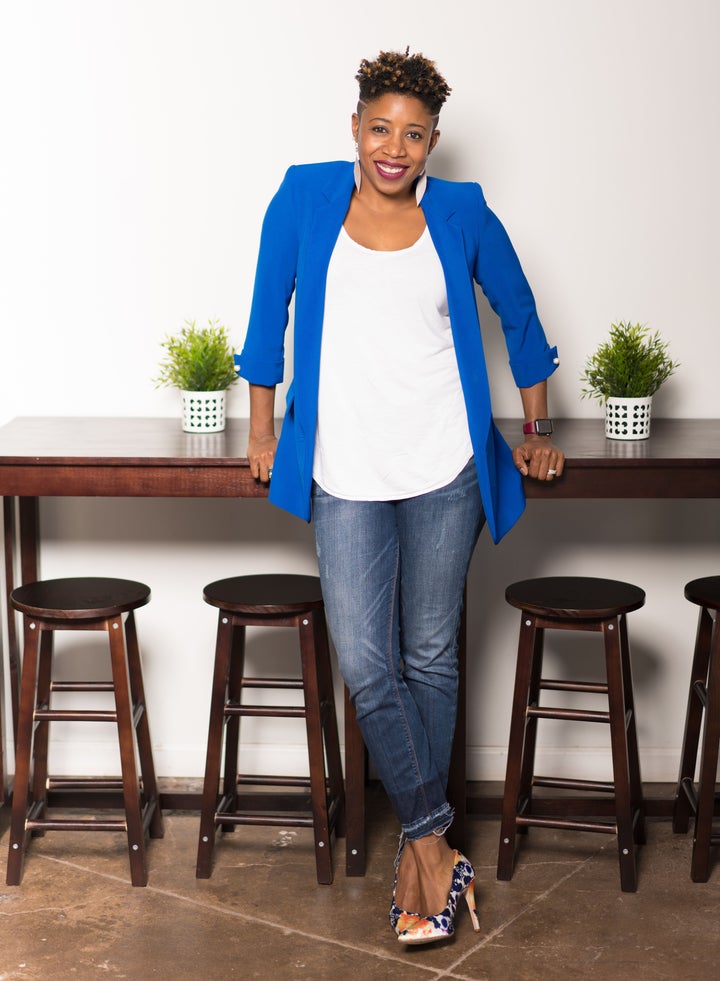Not unlike going on a first date or a job interview, visiting a therapist for the first time can feel like an audition. What if they judge me? What will they write down in their little notebook about me? And trickiest of all: What should I wear?
If you’ve ever changed into “presentable” clothes before heading to a therapy session, it might be comforting to know that therapists care how you perceive them, too.
Clinical social worker and therapist Rachel Colon said she puts “a lot of thought” into getting dressed for her job, especially when meeting a first-time patient. Colon said she assumes the person coming to see her is thinking, I hope this person has it together because right now I’m really struggling, and attempts to express her trustworthiness at least in part through clothing. “You want patients to see that you’re put together and that you’re dressed in a way that’s neat, that you’re going to be able to hold space for this person,” she said.

Colon specializes in treating trauma survivors and often works with children and adolescents. The needs of young patients dictate much of what she wears ― mostly pants and machine-washable pieces from Ann Taylor Loft and Express that she can easily move around in. “If I wear a dress, it’s because I’m working with adult patients that day, so I won’t be required to get on the floor.”
Footwear that makes it into her regular rotation must be practical, too. “I tend to wear shoes that have memory foam in them just in case I have to chase a kid if they run out of the office,” Colon said.
With adults, Colon finds that patients want a therapist who seems capable of empathizing and understanding their pain. Though it wouldn’t be her style anyway, she said she wouldn’t show up to an appointment flaunting diamonds and high-end brands. “If we’re coming in dripped in Louis Vuitton and Yves Saint Laurent,” she said, patients might ask themselves if this person will really be able to comprehend their problems.
As for makeup and perfume, Colon keeps it simple. “I’m doing a lot of talking with my mouth,” she said, “so the majority of the time the focus is right there.” Though a fan of MAC makeup’s brighter hues in her personal life, she sticks to neutral shades that won’t require frequent reapplication on the job. And since trauma memories are often strongly connected to scent memories, she doesn’t want to risk triggering anyone with familiar scents. Instead, Colon uses “a lot of oils, like lavender or peppermint, or those scents that are calming to the nervous system.”

Clinical psychologist and author Ellen Hendriksen said her workwear choices are also about functionality. “I try to wear clothes that I can go out in the world in, like low-heeled shoes or boots,” she explained — and “no pantyhose.” Her therapy often involves taking patients outside the office and her clothes need to be able to handle the elements.
“If I’m treating social anxiety, we’re going to go to Starbucks and spill our coffee. If I’m working with someone with a height phobia, we’re going to go to a building with tall glass elevators and go ride them up and down,” Hendriksen said. “So I need to be able to be mobile, unlike most therapists who stay in the office and talk.”
Asked to summarize her style at work, Hendriksen called it “kind of generic professional.” She sticks to a neutral palette in both color and silhouette, she said, because “it’s [my patient’s] hour. It’s not my hour.” She sees her practice as “my patients’ place to express themselves. And I want them to feel comfortable with me, like they can project what they need onto me.”
For psychologist Melanie Robinson-Brown, creating an environment where patients can express themselves starts with putting her own identity on display. Robinson-Brown said it’s important that she feel like the truest version of herself when working with patients, which is why she gravitates toward structured pieces with bright colors and fun accessories. By bringing her “real” self into her office, she explained, “I’m going to make someone feel much more comfortable because there’s continuity between what I’m saying and what you’re seeing.”
Though her niche is “working with women,” she deals with a variety of patients. Robinson-Brown said she doesn’t dress differently depending on who’s walking in the door. “I don’t want to have to play a code-switch type of game where depending on who I’m sitting across from, I have to dress differently.”

Robinson-Brown said she finds patients appreciate her authenticity. “I get a lot of, ‘OK, so where do you go shopping?’” from patients. “There’s definitely a positive response.”
Most importantly, she wants her clothing to make everyone feel like they can be themselves in her office and out in the real world.
“I think it’s so important to show my clients that it’s OK to show up as you,” she said, especially at work. “Women can get pigeonholed [by the idea that] you need to look a certain way when you go to work, whether that means a suit or neutral black-and-white colors,” Robinson-Brown said. But as long as you’re dressed appropriately and love what you do, the psychologist suggests you “throw that shit out the window and just be you.”
In practice over 40 years, psychoanalyst Jonathan Berent has witnessed many changes to the industry. “In 1985, you put on your suit” to meet with patients, Berent said. Since then, changing attitudes about appropriate workwear have led him to loosen up his professional uniform. Moreover, with his increasingly international client base, he said, “At this point, 99.9% of what I do is on Skype and telephone,” meaning he can wear whatever he chooses.
Clinical psychologist Amelia Aldao likewise noted that ideas about what therapists “should” wear to work have changed since she was in graduate school. “When I was in training, there was sort of a ‘business casual look’” expected of therapists, she said, one that included “slacks, a nice top, a dress” and no jeans.
It also seemed like what she wore was a bigger concern because she was young and still in training, Aldao said. “When you are 24 or 25 years old, most of your clients are going to be older.” Wearing more formal business wear can help project maturity and professionalism to patients who might question the authority of a young therapist.

Now that she has her own clinic, though, Aldao said she has left those confining standards behind. “I have friends who still get super dressed up to see their clients and that’s great too,” she said, “but I just like to be comfortable.” Aldao prefers to channel her design energy into creating a soothing office environment for her patients. For her outfits, she sticks to sweaters, sneakers — and, yes, jeans.
That doesn’t mean she doesn’t think about her appearance from time to time, particularly if she’s having an off day. “If I’m having a terrible hair day, I’m like, ‘Oh god, I’m supposed to be an expert,’” Aldao said.
Generally, what therapists really worry about is what they said to their patients. We all have moments when we feel uncomfortable with our appearance, but Aldao said that in her experience, “It’s a lot more about saying the right thing than looking the right way.”
Credit: Source link